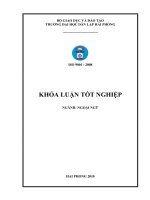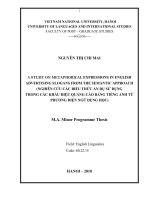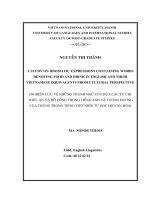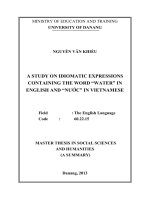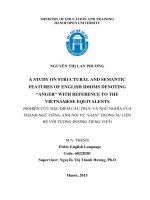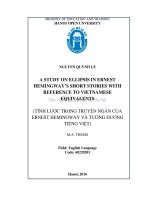A study on metonymic expressions concerning humans in oscar wildes short stories with reference to vietnamese equivalents
Bạn đang xem bản rút gọn của tài liệu. Xem và tải ngay bản đầy đủ của tài liệu tại đây (1.08 MB, 58 trang )
VIET NAM NATIONAL UNIVERSITY OF AGRICULTURE
FACULTY OF EDUCATION AND FOREIGN LANGUAGES
BA THESIS
A STUDY ON METONYMIC EXPRESSIONS
CONCERNING HUMANS IN OSCAR WILDE’S
SHORT STORIES WITH REFERENCE
TO VIETNAMESE EQUIVALENTS
(NGHIÊN CỨU VỀ PHÉP HOÁN DỤ LIÊN QUAN ĐẾN
CON NGƯỜI TRONG TRUYỆN NGẮN CỦA
OSCAR WILDE CÓ THAM CHIẾU ĐẾN
NGHĨA TƯƠNG ĐƯƠNG TRONG TIẾNG VIỆT)
Student:
DAO DAI VU
Student code:
621236
Major:
ENGLISH
Supervisor:
NGUYEN THI THU THUY, Ph.D.
Hanoi – 2021
CERTIFICATE OF ORIGINALITY
I, the undersigned, hereby certify my authority of the study project report
entitled “A STUDY ON METONYMIC EXPRESSIONS CONCERNING
HUMANS IN OSCAR WILDE’S SHORT STORIES WITH REFERENCE TO
VIETNAMESE EQUIVALENTS” submitted in partial fulfillment of the
requirements for the degree of Bachelor in English Language. Except where the
reference is indicated, no other person’s work has been used without due
acknowledgement in the text of the thesis.
Hanoi, 2021
Đào Đại Vũ
Approved by
SUPERVISOR
Nguyen Thi Thu Thuy, Ph.D.
Date:……………………
i
ACKNOWLEDGEMENT
First of all, I would like to thank the enthusiastic guidance of teachers at
the Faculty of Education and Foreign Language those have helped me complete
my BA thesis during the past 5 months. Thanks for providing me with both
professional knowledge and learning spirit, which is the foundation to help me
acquire practical knowledge during the process of completing this BA thesis.
I would like to express my deepest gratitude to Nguyen Thi Thu Thuy,
Ph.D. who gave me many detailed comments and reviews so that I can draw
from my own experience through this BA thesis. Thank you very much for your
kind cooperation during this time helping me complete the BA thesis.
Besides, I would like take this opportunity to sincerely thank my family
and my friends for being supportive of my education and always being by my
side through hard times.
ii
TABLE OF CONTENT
PART 1: INTRODUCTION.................................................................................................................1
1. RATIONALE FOR THE STUDY ...................................................................................................1
2. AIMS AND OBJECTIVES OF THE STUDY.................................................................................1
2.1. AIMS .........................................................................................................................................1
2.2. OBJECTIVES ...........................................................................................................................2
3. RESEARCH QUESTIONS ..............................................................................................................2
4. SCOPE OF THE STUDY ................................................................................................................2
5. SIGNIFICANCE OF THE STUDY .................................................................................................2
6. DESIGN OF THE STUDY ..............................................................................................................3
PART 2: DEVELOPMENT ..................................................................................................................4
CHAPTER 1 - LITERATURE REVIEW ............................................................................................4
1.1. REVIEW OF THE PREVIOUS STUDIES...................................................................................4
1.2. REVIEW OF THEORETICAL BACKGROUND........................................................................5
1.2.1. Definition of Metonymy.........................................................................................................5
1.2.2. Characteristics of Metonymy .................................................................................................7
1.2.3. Classification of Metonymy ...................................................................................................8
1.2.4. Features of Metonymy ...........................................................................................................8
1.2.5. Types of Metonymic Expressions concerning humans in English and Vietnamese ..............9
1.2.6. Metonymy Concerning Humans ..........................................................................................15
1.2.7. Metonymy versus Other Ways of Meaning Transference ....................................................16
1.2.8. Oscar Wilde and the Short stories ........................................................................................16
CHAPTER 2 - METHODOLOGY .....................................................................................................18
2.1. RESEARCH METHOD ..............................................................................................................18
2.2. DATA COLLECTION ................................................................................................................19
2.3. ANALYTICAL FAMEWORK ...................................................................................................19
2.4. SUMMARY ................................................................................................................................22
CHAPTER 3 - FINDINGS AND DISCUSSIONS .............................................................................23
3.1. METONYMIC EXPRESSIONS CONCERNING HUMANS IN ENGLISH AND
VIETNAMESE ..................................................................................................................................23
3.1.1. The Part for the Whole .........................................................................................................23
3.1.2. Institution for People ............................................................................................................26
iii
3.1.3. The Concrete for Abstract ....................................................................................................26
3.1.4. Container for People Contained ...........................................................................................29
3.1.5. Color for People ...................................................................................................................30
3.1.6. Object Used for User ............................................................................................................31
3.1.7. Author for His Work ............................................................................................................32
3.2. SIMILARITIES ...........................................................................................................................32
3.3. DIFFERENCES ..........................................................................................................................33
3.4. FEATURES OF METONYMY ..................................................................................................34
3.4.1. Syntactic features .................................................................................................................34
3.4.2. Semantic features .................................................................................................................37
3.5. SUMMARY ................................................................................................................................38
PART 3: CONCLUSION.....................................................................................................................39
1. RECAPITULATION .....................................................................................................................39
2. CONCLUDING REMARKS .........................................................................................................39
3. LIMITATION OF THE STUDY ...................................................................................................41
4. RECOMMENDATIONS FOR FURTHER STUDY .....................................................................42
REFERENCES .....................................................................................................................................43
APPENDIX ...........................................................................................................................................45
iv
ABSTRACT
The cognitive linguistics approach to metonymy provides an explanatorily
elegant framework to account much for the underlying meaning. In this paper,
we identify and describe syntactic and semantic features of metonymic
expressions in Oscar Wilde’s short stories with reference to Vietnamese
equivalents. We will be using comparison-contrast method and analytical
method to analyze and examine metonymic expressions from “The Happy
Prince”, “The Selfish Giant”, “The Nightingale and the Rose” by Oscar Wilde
and some other literature works, “Chiếc lư đồng mắt cua”, “Chiếc Va-ly mới”,
“Đi mở đường” by Nguyễn Tuân, “Chí Phèo” and by Nam Cao to clarify the
similarities and differences of these metonymic expressions. Through this study,
we have found the similarities and differences in using metonymic expressions
concerning humans between Oscar Wilde and some other authors and
Vietnamese writers. At the end, as the result, the study offers teachers and
learners of English and Vietnamese a comprehensive perspective on metonymic
expression in short stories concerning humans using a cognitive linguistics
approach.
KEYWORDS: Metonymic expression, Metonymy, Human, Oscar Wilde, Short
story.
v
LIST OF ABBREVIATIONS
ICM:
Idealized cognitive model
NP:
Noun Phrase
vi
LIST OF TABLES AND FIGURES
Table 2.1.
Types of metonymy concerning humans
Table 2.2.
Syntactic Functions of Metonymic Expressions as Noun Phrases
Table 2.3.
Semantic feature: Metonymy as a Polysemous Phenomenon
Table 3.1.
Types of Metonymic Expressions Concerning Humans In English
And Vietnamese works
Table 3.2.
Syntactic functions of the metonymic Noun Phrases in Oscar
Wilde’s short story and Vietnamese short story
Table 3.3.
Polysemy of metonymic ‘Face’
Figure 3.1. Syntactic functions of the metonymic Noun Phrases in Oscar
Wilde’s short story and Vietnamese short story
Figure 3.2. Referential Meaning of Author-for-Work Metonymy
vii
PART 1: INTRODUCTION
1. RATIONALE FOR THE STUDY
Along with poetry, music and other artistic works, short story has long
been everyone’s spiritual food. Short story not only brings pleasure and
relaxation to our soul but it also expresses the spiritual depth of writer’s feelings
and emotions. The most important elements of short story are the selective
details, large amount and the writing style with many hidden meanings, giving
the work unspeakable depth. However, short story readers sometimes find it
hard to understand and to snatch the language of short stories. There is a lot to
do while reading short stories because the authors always use a lot of rhetorical
devices to make their work more valuable and worthwhile to read.
It is true that foreigners studying Vietnamese and Vietnamese learners of
English find it difficult to comprehend the short story's directions and characters'
moods using metonymic expressions. As a result, understanding the metonymic
mechanism in short stories will help readers to easily access the content of the
works. All the things above have aroused my interest in researching the topic:
“A Study on Metonymic Expressions Concerning Humans in Oscar Wilde’s
Short Stories with Reference to Vietnamese Equivalents”.
2. AIMS AND OBJECTIVES OF THE STUDY
2.1. AIMS
The study is aimed at examining metonymic expressions concerning
humans in Oscar Wilde’s short stories with reference to Vietnamese equivalents.
1
2.2. OBJECTIVES
This study is planed:
- To identify and to describe syntactic and semantic features of
metonymic expressions in Oscar Wilde’s short stories with reference to
Vietnamese equivalents.
- To compare and contrast metonymic expressions concerning humans in
Oscar Wilde’s short stories with reference to Vietnamese equivalents to clarify
the similarities and differences of these metonymic expressions.
3. RESEARCH QUESTIONS
1. What types of metonymic expressions concerning humans are used in
English and Vietnamese stories?
2. What are the similarities and differences in syntactic and semantic
features between English and Vietnamese metonymic expressions concerning
humans?
4. SCOPE OF THE STUDY
This study will observe and describe some commonly used types of
means for expressing metonymic expression concerning humans in Oscar
Wilde’s short stories such as “The Happy Prince”, “The Selfish Giant”, “The
Nightingale and the Rose” by Oscar Wilde, “Treasure Island” by Robert Louis
Stevenson, “The Thorn birds” by Colleen McCullough, “Chiếc lư đồng mắt
cua”, “Chiếc Va-ly mới”, “Đi mở đường” by Nguyễn Tuân, “Chí Phèo” by Nam
Cao.
5. SIGNIFICANCE OF THE STUDY
The study offers teachers and learners of English and Vietnamese a
comprehensive perspective on metonymic expression in short stories concerning
humans using a cognitive linguistics approach.
2
6. DESIGN OF THE STUDY
Apart from abstracts, references & appendices, the study consists of three
main parts:
PART 1 – INTRODUCTION presents rationale of the study, aims and
objectives of the study, research questions, the scope as well as the significance
of the study.
PART 2 - DEVELOPMENT is divided into 3 chapters:
Chapter 1 - LITERATURE REVIEW provides theoretical
background for the study including definitions of metonymy, typical features of
metonymy, figures of speech, metonymic expression in cognitive linguistics,
metonymic expression concerning humans, metonymy versus other ways of
meaning transference.
Chapter 2 - METHODOLOGY describes the methodology used
in the research including the research methodology, data collection instruments
and data analysis.
Chapter 3 - FINDINGS AND DISCUSSIONS reports and
discusses the findings of the study.
PART 3 - CONCLUSION summarizes the main issues that have been
addressed in the study, points out the limitations, draws pedagogical
implications concerning the research topic and suggests several solutions.
3
PART 2: DEVELOPMENT
CHAPTER 1 - LITERATURE REVIEW
1.1. REVIEW OF THE PREVIOUS STUDIES
Trần Xuân Trưởng (2011) wrote a thesis namely “An investigation into
metonymy denoting humans in English and Vietnamese poetry”. In that thesis,
he pointed out characteristics of metonymic expressions in English and
Vietnamese poetry, giving implications for English teaching and learning
concerning the use of metonymic expressions as well as suggesting solutions for
English teaching and learning. However, in that thesis, he did not work on
metonymic expression in short stories and that is what I would like to research
in this thesis.
Nguyễn Diệu Linh (2014) wrote an article “Metonymy “The-Part-ForThe-Whole” of People in “Treasure Island” by Robert Louis Stevenson”. She
believes that the-part-for-the-whole kind of metonymy can be served for many
purposes, especially, for people. This article analyzed the-part-for-the-whole
kind of metonymy in “Treasure Island” by Robert Louis Stevenson to address
that problem and proposed some suggestions for teaching and learning English
rhetorical devices. She listed and examined metonymies related to parts of
human’s body by using analytical method. The drawback of her article is that
the scope limited in only one subtype of metonymy.
Lin Wei (2010) has completed a research paper “A Cognitive Approach to
Metaphor and Metonymy Related to the Human Body”. This study is an attempt
to investigate the body metaphors and body metonymies applied in the body
terms from the perspective of cognitive linguistic. Through the analysis of
linguistic metaphorical and metonymic expressions of body terms, this study
summed up two main mapping models and three kinds of image schema of body
4
metaphor. The essay analyzed part-and-whole and part-and-part body
metonymy. Furthermore, it also pointed out the similarities and differences
between metaphor and metonymy. However again in this research he did
mentioned different types of metonymy but did not analyzed all of them.
After realizing the potential for further development and exploitation from
the limitations of the above studies, I would like to do an in-depth study on
metonymic expression related to humans in short stories written by Oscar Wilde
and other authors with reference to Vietnamese equivalents to see the
differences between using metonymic expression in literature in different
languages.
1.2. REVIEW OF THEORETICAL BACKGROUND
1.2.1. Definition of Metonymy
According to Lakoff and Johnson’s “Metaphors We Live By” (1980:30),
metonymy is defined as “the use of one entity to stand for another which is
related to it”. From their point of view, metonymy has a primarily referential
function, but it also contributes to understanding.
Lakoff (1987: 78) defines metonymy as a stand-for relation that exists
solely in one idealized cognitive model (ICM). A conceptual domain, or ICM,
can be viewed as as a whole made up of parts; more specifically, the conceptual
entities, or elements, are the components that make up the ICM as a whole.
Some background conditions in a given ICM include the "stands for" relation
that may exist between two elements A and B, such that one element of the
ICM, B, may stand in for another element A. Given this perspective, ICM
metonymies may occur in two ways. (1) either a part stands for a whole or a
whole stands for a part, (2) a part stands for another part (Kövecses, 2002: 150).
5
According to Lakoff and Turner (1989), metonymy is a type of conceptual
mapping. The key element here is that metonymy is viewed as a cognitive tool
for conceptualization rather than a linguistic strategy or rhetorical tactic.
Metonymy, according to the traditional view, is primarily the use of one
term in lieu of another to refer to some entity, where one word can be used for
another if the meanings of the words are contiguously related. Metonymy is
conceptual in nature, according to cognitive linguistics, and its major role is to
give mental access from one conceptual entity to another; it is based on ICMs
with a distinct conceptual link between their constituents (Kövecses, 2002: 160).
Jeannette Littlemore (2015) defined metonymy as a cognitive and
linguistic process through which we use one thing to refer to another.
Langacker describes metonymy as “a process consists in mentally
accessing one conceptual entity via another entity” (1993. p.30).
Blank considers metonymy as “a linguistic device based on salient
conceptual relations within a frame network” (1999, p.174). In this definition,
Blank points out that “salient” is an important notion in the view of metonymy.
Later, Radden and Kovecses define metonymy as follows from a
cognitive standpoint: “metonymy is a cognitive process in which one conceptual
entity, the vehicle, provides mental access to another conceptual entity, the goal,
within the same ICM” (1999, p.21).
According to Dinh Trong Lac (1994), he gave the definition of metonymy
in “99 phương tiện và biện pháp tu từ định nghĩa”: “Metonymy is the second
entity that bases on the actual relationship between identified entity and entity
whose name is transferred to the identified entity.” (“Hoán dụ là định danh thứ
hai dựa trên mối liên hệ hiện thực giữa khách thể được định danh với khách thể
có tên gọi được chuyển sang dùng cho khách thể được định danh”).
6
Thai Hoa (1995) discussed in “Phong cách học Tiếng Việt” that:
“Metonymy is the method of switching meaning by using a typical characteristic
or feature of an object to name that object.” (“Hoán dụ là phương thức chuyển
nghĩa bằng cách dùng một đặc điểm hay một nét tiêu biểu nào đó của một đối
tượng để gọi tên chính đối tượng đó”).
Overall, despite their differing perspectives, most cognitive linguists
believe that the metonymic process consists in mentally accessing one
conceptual entity via another entity; Metonymy is more than just a figure of
speech; it is part of people's everyday thinking; and its function is not just to
attain some artistic or aesthetic goal, but rather to better understand concepts. It
is a helpful cognitive tool for anyone attempting to grasp the world.
1.2.2. Characteristics of Metonymy
According to Zhang Hui & Sun Mingzhi, metonymy has the following
characteristics:
Conceptual metonymy is a kind of cognitive operation within which
source domain provides access to target domain.
The relation between source and target domains is contingent and
conceptually not necessary.
The target meaning of metonymy is salient with the source meaning
backgrounded.
Metonymy as natural inferential schemata plays a vital role in speech acts.
High-level and low-level metonymy must be distinguished on the basis of
classification of referential, predicational and illocutionary metonymy.
Conceptual integration provides some motivations for the interpretation
and understanding of metonymy.
7
1.2.3. Classification of Metonymy
According to Jialing Guan (2009), classification of metonymy is one of
the crucial concerns of research as it contributes to understanding the exact
nature of metonymy. There are some major cases of metonymy:
Containment
A physical item, place, or body part used to refer to a related concept
Tools/instruments used to signify the job it does or the person who does
the job.
Product for process
A part of something/someone is often used for the whole or the whole of
something/someone is used for a part.
A country's capital or some location within the city is frequently used as a
metonym for the country's government; other important places are
commonly used to refer to the industries that are located there
1.2.4. Features of Metonymy
1.2.4.1. Syntactic features
According to Trần Xuân Trưởng (2011), there are two syntactic features
of metonymy:
a. Syntactic patterns of Noun phrases as Metonymic Expressions
b. Syntactic Functions of Metonymic Expressions as Noun Phrases
1.2.4.2. Semantic features
According to Trần Xuân Trưởng (2011), the three main semantic features:
a. Transfer of Metonymic Expressions’ Meanings
b. Metonymy as a Referential Phenomenon
c. Metonymy as a Polysemous Phenomenon
8
1.2.5. Types of Metonymic Expressions concerning humans in English and
Vietnamese
According to Radden and Kövecses (1999), Jeannette Littlemore (2015)
and Trần Xuân Trưởng (2011), we have divided metonymic expressions in
English and Vietnamese into 7 types:
The Part for the Whole
Institution for People
The Concrete for Abstract
Container for People Contained
Color for People
Object Used for User
Author for His Work
1.2.5.1. The Part for the Whole
This type of metonymy is usually known as “synecdoche”. It can be a
word or phrase in which a part of something is used to refer to the whole of it.
Ex:
(1) We all live under the same roof.
In this example, roof - a part of the house is used to refer to the whole
house because we live in a whole house and not just literally under the roof.
(2) I have three mouths to feed.
In the example above, mouth - a part of a human body is used to refer to a
person.
New blood – is used to refer to a newbie, new people.
(3) The team needs some new blood if it’s going to win next season.
New blood is used to refer to new person. Blood is only a part of the
body, but it refers to the whole person.
9
1.2.5.2. Institution for People
An institution can stand for the people involved in that institution. That
reference can be military troop, the government or an organization.
Ex:
(4) Exxon has raised its prices again.
In the example above, Exxon is the name of a company. The “company”
itself cannot make the decision to raise prices, but rather, it must be Exxon
management to make the decision.
Some other examples:
(5) You will never get the university to agree to that.
(6) The Army wants to reinstitute the draft.
(7) The Senate thinks abortion is immoral.
(8) I don’t approve of the government’s actions.
1.2.5.3. The Concrete for Abstract
Metonymy in literature often substitutes a concrete image for an abstract
concept.
Ex:
(9) From the cradle to the grave.
In this example, cradle is used to refer to birth because when infants are
born, they are usually put in a cradle; on the other hand, grave is used to refer to
death because when people die, they are usually buried in the grave. Therefore,
this sentence is interpreted as “from birth to death” instead of literally “from the
cradle to the graveyard”.
Heart – is used to refer to love, emotion.
(10) My dear, you have all of my heart.
10
In this sentence, the heart is a concrete concept used to replace the
abstract concept of love.
Ears – pay attention, listen carefully.
(11) Tell me about your first date. I’m all ears!
In the example above, ears (concrete) refers to paying attention (abstract).
Hand – refers to helping.
(12) Can you give me a hand carrying this box up the stairs?
In this sentence, he/she did not actually mean to ask for the hand but to
ask for help.
Tongue – refers to language.
(13) I couldn’t understand them because they spoke in their mother
tongue.
1.2.5.4. Container for People Contained
This is manifested in sentences like “The Vietnamese believes that ...”
where the Vietnamese is the people-involving entity. The following are some of
the most common types of a "people-involving entity," along with the types of
individuals who are typically thought to be engaged:
A country - leaders or members of the population
An institution (e.g., the WHO, the Army) - members or leaders
A board or committee - members
A newspaper - editors or journalists
A faction (e.g., the Left) - members or leaders
11
But there are many other possibilities. For example: “[the] editorial page
has always believed ...” Here we presumably have a metonymic reference to the
editors.
Which particular people are implicitly referred to can be highly context
dependent? For example, in sports news article the phrase “the Vietnamese”
might refer metonymically to the members of the Vietnamese Olympic
swimming team. Also, the precise people involved can not be inferred, often.
In some cases the metonymy is used in concerning to the holders of
mental states, as in “The Vietnamese believes that ...” Of course, the metonymy
can also be used for other purposes.
Ex:
(14) The New York Times always reports quickly and promptly.
1.2.5.5. Color for People
According to Oxford Advanced Learner’s English-Chinese Dictionary
(6th Edition) (to hereafter to as: Oxford), the initial paraphrase on “black” is
“having the very darkest color, like night or coal”. So, if on etymology, “black”
refers to a particular color; if on cognitive linguistics, its archetype meaning
belongs to paint gamut. The senses of “black” are closely connected with one
another, the author attempts to group the metonymical and metaphorical
meanings into several categories. The categorization is shown as follows.
a. Visual-Metonymy
Light and dark are the foremost direct experience in our existence.
Wierzbicka (1996) believed that the notion of “black” and “white” may be
inherently related to “dark” and “light”. The notion of seeing is that the clue to
the semantics of dark and light, which the prototypical use of those words has
nothing to do with any objects but with the ambient. Thus we will say “It was
(already) dark.” or “It was (still) light”. Though “black night” relies on human
12
experience, it's way more abstract meaning, which may be classified into visual
gamut.
Ex:
(15) He groped for the door handle within the black.
(16) Darkness was blacking out both sea and jungle.
(17) It’d be a black night with the rain.
The neurological firing pattern for low brightness signals black, and its
relative absence signals white, with gray in between (Zhao, 2001: p. 42). Black
is to human eyes the foremost distinct of color experiences. Black can make
people consider night and darkness. The physical experience facilitates
metonymic transfer of black from blackness to darkness, as in “black night”.
they're physically grounded and their meanings come directly from our
perceptual proximity between “black” and “dark”. within the above examples,
“black” means “without light, completely dark”. Through “black” to elicit
“night”, it points out the close relationship between two things, which is the
results of metonymic cognition.
b. Emotional-Metonymy
Everyone has a bad mood at some point, thus being restless. we will
realize someone not only by oral expression but also facial features. “Black”
also can mean “gloomy, somber”. this type of metonymy is simply using
different facial colors to precise emotional change.
Ex:
(18) Rory shot her a black look.
(19) He was black and blind with hatred of her.
(20) You had almost charmed away my black mood.
Someone goes black when he feels surprised or frightened. The
connection between cause and effect could be a reasonably metonymy.
13
c. Racial-Metonymy
In objective world, people from different races have their own distinct
features, which might always be easily perceived and memorized. The people
within the Orient are mainly yellow or brown, so people use “yellow race” to
call them; those within the west are mainly white, so people use “white people”.
Of course, the naming process is realized by metonymy.
Ex:
(21) A black woman broadcaster.
(22) Black culture.
(23) This has made new black investors wary.
In Oxford, here “black” means “belonging to a race of people who have
dark skin; connected with black people”.
d. Thing-Metonymy
Thing metonymy of color terms uses colors to refer to things themselves.
like “green apple”, “the white book”, “blue print” and so on. in this type of
usage, “black” means “without milk”.
Ex:
(24) Two black coffees, please.
In this case, “black coffee” refers to “coffee without milk or coffee mate”.
and we call “coffee milk” as “white coffee”. Moreover, “Hongcha” should be
translated as “black tea” not “red tea”. In Chinese and also the languages of
neighboring countries, it's an outline of the color of the liquid. The western term
“black tea” refers to “the color of the oxidized leaves”. While green tea usually
loses its flavor within a year, black tea retains its flavour for several years.
Although green tea has been recently seen as a revival due to its purported
health benefits, black tea still accounts for over ninety percent of all tea sold
within the west.
14
1.2.5.6. Object Used for User
This type of metonymy is popularly found in novel and poems thanks to
the understandable contiguity from the close relation of the object and the
person using that object.
Ex:
(25) The buses are on strike.
In the example above, the bus cannot be on strike but it refers to the
people in the bus who are the ones on strike. So the sentence can be interpreted
as “The people on the bus go on strike instead of the buses are on strike.”
Some other examples:
(26) The sax has the flu today.
(27) The BLT is a lousy tipper.
(28) The gun he hired wanted fifty grand.
(29) We need a better glove at third base.
1.2.5.7. Author for His Work
This type of metonymy is using the auther’s name to refer to their works.
Ex:
(30) He’s got a Picasso.
Picasso is the name of a famous artist, so in the sentence above, Picasso is
used to refer to the painting of him. Instead of understanding as “He has the
artist Picasso”, the sentence is interpreted as "He has a painting of Picasso".
1.2.6. Metonymy Concerning Humans
According to “Towards a Theory of Metonymy” (1999, p.45), Klaus-Uwe
Panther and Günter Radden consider our basic human experience are delivered
from our anthropocentric view of the world and out interaction in the world. In
this world, humans take precedence over non-humans, things are looked at from
15
a subjective rather than objective point of view, concrete objects are more salient
than abstract entities, things we interact with are selected over things we do not
interact with, and functional things are more important to us than things which
are non-functional.
Human over non-human
Subjective over objective
Concrete over abstract
Interactional over non-interactional
Functional over non-functional
1.2.7. Metonymy versus Other Ways of Meaning Transference
1.2.7.1. Metonymy versus Metaphor
Metonymy is based on the similarity (association) of two concepts,
whereas metaphor is based on the similarity of two concepts. When people use
metonymy, they do not typically wish to transfer qualities from one referent to
another as they do with metaphor: there is nothing press-like about reporters or
crown-like about a monarch, but "the press" and "the crown" are both common
metonyms.
1.2.7.2. Metonymy versus Synecdoche
When people speak of a part of something yet imply the entire thing, they
utilize synecdoche. Metonymy is similar, except it substitutes something more
broadly or tangentially related to an idea.
1.2.8. Oscar Wilde and the Short stories
Oscar Wilde, in full Oscar Fingal O’Flahertie Wills Wilde, (born October
16, 1854, Dublin, Ireland - died November 30, 1900, Paris, France), Irish wit,
16
poet, and dramatist whose reputation rests on his only novel, The Picture of
Dorian Gray (1891), and on his comic masterpieces Lady Windermere’s Fan
(1892) and The Importance of Being Earnest (1895). He was a spokesman for
the late 19th-century Aesthetic movement in England, which advocated art for
art’s sake, and he was the object of celebrated civil and criminal suits involving
homosexuality and ending in his imprisonment (1895–97).
Oscar Wilde was grown up in a prosperous family. He had seen many
intellectuals of his time dining with his parents and took great advantage from
their company. He was awarded a royal school scholarship in 1871 and got his
education from Trinity College from where he was awarded by a famous
honorary award for undergraduates in 1872. He took great interest in poetry and
wrote a poem "Ravenna" in 1878 and won a Newdigate prize for composing the
best English verse. He published his first collection of poems in 1881 and after
seven years of his poems' publication, he published a collection of stories for
children named, The Happy Prince and Other Tales (1888). At the peak of his
fame, he was victimized for homosexuality and convicted. He had to spend two
years in jail and afterward, he went to France. He had produced great work and
known for his masterpieces even up till now. All his tales are the source of
entertainment and moral awakening not only for children but also for adults.
Through the analysis of the selected passages in this paper, his linguistic
ability is shown clearly in the way he uses metonymic expressions when
expressing his emphasis. He attempted to be a Victorian esthete by writing
books or works that are attractive in both color and cadence, and all of his
writings are highly fashioned.
17
